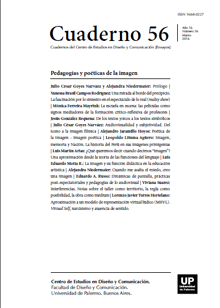¿Qué queremos decir cuando decimos “imagen”? Una aproximación desde la teoría de las funciones del lenguaje
Abstract
On revising the opposition between the concepts “linguistic turn” (Rorty) and “iconic turn” (G. Boehm and W. Mitchell) we will aim to reflect on the “image” within an extended consideration of language, understood as a general structure or system that encompasses all of human cultural activity, in the same direction, but always played with a critical spirit, of those classic postulates by Lévi-Strauss and Barthes and finally considering that beyond language, but in dialectical relationship with him, we find precisely the real (Lacan); concept which is itself revised from those proposed by JG Requena, particularly through the development of his conception of the photographic image as “trace of reality.” From these theoretical assumptions we propose a new theory that combines textual analysis or theory of text epistemology or philosophy of knowledge, so as to take into account all three functions performed in the epistemological field and epistemological language, in general, delving a little deeper into the objectives of this work in relation to what we call “image”. These three functions of language are scientific (objective knowledge), poetic (subjective knowledge) and, above all, the ideological function (which leads us to the not knowing or ignorance of the world), which is the most full of meaning and the worse theorized so far, but it has a great importance in the field of what we call education or pedagogy.
References
Anónimo (2013). Symploké. Entrada “Imagen”: “Objeto sensorial parecido a otro considerado original, sustituido por idea y representación en la filosofía moderna”. Disponible en: symploke.trujaman.org. Consultado: 21-2-2013
Ariso, José María (2008). “Cautivos de imágenes. Un ejemplo de filosofía terapéutica”. En: revista Escritura e imagen UCM, Vol. 4.
Barthes, Roland. (1978). Sistema de la Moda. Ed. Barcelona: Ed. Gustavo Gilli.
Bueno, Gustavo (2002). Telebasura y democracia. Barcelona: Ediciones B.
Freud, Sigmund (1981). Tres ensayos para una teoría sexual. Madrid: Ed. Biblioteca Nueva. García Jiménez, Jesús. “La televisión escolar en España (Relato de una experiencia única)”. En: Revista de Tecnologías de la Información y Comunicación Educativas, nº 4.
González Requena, Jesús (2010). “Lo Real”. En: revista Trama y Fondo (T&F) nº 29.
González Requena, Jesús (2006). Clásico, manierista, postclásico. Valladolid: Ed. Castilla Ediciones.
González Requena, Jesús (1998). “En el principio fue el Verbo. Palabra versus Signo”. En revista Trama y Fondo (T&F) nº 5.
González Requena, Jesús (2001). “Lo Radical que habita la Máquina Fotográfica”. En: revista Fabrikart. Arte, Tecnología, Sociedad, nº 1.
Ledesma, María (2013). “El giro icónico”. Primer Simposio internacional interdisciplinario. Aduanas del conocimiento. La traducción y la constitución de las disciplinas entre el Centenario y el Bicentenario. Disponible en: www.expoesia.com/media/Ponencia_Ledesma.pdf. Consultado: 21-2-2013.
Lombrozo, Tania (2013). “Illusions Of Understanding And The Loss Of Intellectual Humility”.
Disponible en: edge.org/response-detail/23731. Consultado: 15-4-2013.
Martín Arias, Luis (2009). En los orígenes del cine. Valladolid: Ed. Castilla Ediciones.
Martín Arias, Luis (2011). “Lenguaje y conocimiento”. En: revista Trama y Fondo (T&F) nº 31.
Martín Arias, Luis (2012). “De la ideología a la política: la izquierda lacaniana”. En: revista Trama y Fondo (T&F) nº 32.
Mithen, Steven (2007). Los Neandertales cantaban Rap: los orígenes de la música y el lenguaje. Madrid: Ed. Crítica.
Moxey, Keith (2009). “Los estudios visuales y el giro icónico”. En: Revista de Estudios Visuales nº 6.
Schopenhauer, Arthur (2003). El mundo como voluntad y representación vol 1. Barcelona: FCE Círculo de Lectores.
Trías, Eugenio (2007). El canto de las sirenas: argumentos musicales. Madrid: Ed. Galaxia Gutenberg.
Turgueniev, Ivan (2006). Padres e hijos. Madrid: Ed. Rialp.
Wittgenstein, Ludwig (1988). Investigaciones filosóficas, Barcelona: Ed. Crítica.
Los autores/as que publiquen en esta revista ceden los derechos de autor y de publicación a "Cuadernos del Centro de Estudios de Diseño y Comunicación", Aceptando el registro de su trabajo bajo una licencia de atribución de Creative Commons, que permite a terceros utilizar lo publicado siempre que de el crédito pertinente a los autores y a esta revista.


